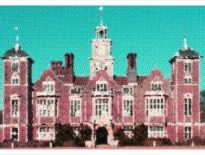On this day in Tudor history, 3rd September 1588, or possibly the 5th September, actor and clown, Richard Tarlton, died in Shoreditch. He was buried in St Leonard's Church, Shoreditch.
Tarlton was a member of the Queen's Men acting company, but is famed for his post-play jigs as a clown. He was also known for being able to cheer up Queen Elizabeth I - how wonderful.
Find out more about Tudor clown Richard Tarlton, his life and career, in today's talk.
Also on this day in Tudor history, 3rd September 1592, Elizabethan writer and playwright Robert Greene died in London. Greene is best known for a pamphlet "Greene's Groats-worth of Wit bought with a Million of Repentance" which he wrote on his deathbed and in which he attacked Shakespeare as an “upstart crow”. Find out more about the man and his pamphlet in last year’s video:
Also on this day in history:
- 1553 – Edward Courtenay was created Earl of Devon. He had been imprisoned in 1538, at the age of twelve, due to his family's links with the Poles and Nevilles, but was released shortly after the accession of Mary I.
- 1557 - News reached London that the English and Imperial troops had been successful in storming St Quentin, and there were widespread celebrations; bonfires were lit, bells were rung and there was singing. The good news was marred, however, by news of the death of Henry Dudley.
- 1597 – Death of Sir John Norreys (Norris), military commander, at his brother Thomas's home, Norris Castle in Mallow, co. Cork. He died in his brother's arms, and it is thought that his death was due to trouble from old wounds, perhaps gangrene. Norris served as a soldier in France, the Low Countries and Ireland.
Transcript:
On this day in Tudor history, 3rd September 1588, or possibly the 5th September, actor and clown, Richard Tarlton, died in Shoreditch. He was buried in St Leonard's Church, Shoreditch. Tarlton was a member of the Queen's Men, but is famed for his post-play jigs as a clown.
Let me tell you a bit more about this Tudor clown…
Very little is known of Tarlton’s beginnings, but in his “History of the Worthies of England, published in 1662, 17th century churchman and historian Thomas Fuller wrote that Tarlton was born in Condover, Shropshire and that his father was a pig farmer there before moving to Ilford in Essex. Tarlton’s will states that his mother was called Katherine and that he had a sister called Helen. Robert Wilson, who was a fellow member of the Queen’s Men, wrote of how Tarlton was a water-carrier in his youth.
In 1570, the name Richard Tarlton appeared on the bottom of a ballad on the “late great floods” which caused problems in that October in Bedfordshire and Lincolnshire. At some point, Tarlton moved to London, and it is thought that he joined the Earl of Sussex’s company of players in the late 1570s and by 1583 he was a founder member of the Queen’s Men company, playing parts including Dericke in “The Famous Victories of Henry the Fifth”. He also became a freeman of the Company of Vintners in 1584, and kept an inn in Colchester, a tavern in Gracechurch Street and an ordinary in Paternaster Row.
In around 1585, he wrote a two part comedy for the Queen’s Men called “The Seven Deadly Sins”, which was popular at the time but no copies of it have survived.
In 1587, he was made Master of Fence, so was obviously accomplished with the sword. He also served as a groom of the chamber.
He may have acted in plays, but he is best known for playing the clown at post-play jigs. Tarlton’s biographer, Peter Thomson, explains that these jigs “were essentially raucous afterpieces: framed as short farces” and that they featured “sexual misdemeanour and cross-dressing”. He goes on to describe Tarlton as “the master clown of the jig” and states that Tarlton not only played the clown, but he wrote his jigs too.
He obviously had a gift for cheering up Queen Elizabeth I, for he was recorded as being able to “undumpish” her when she was unhappy and Thomas Fuller wrote that “her highest Favorites, would in some Cases, go to Tarleton, before they would go to the Queen, and he was their Vsher to prepare their advantagious access unto Her”.
16th century historian John Stow, in his Annales of England, recorded how alehouses used pictures of Tarlton to advertise themselves - “Tarleton so beloued that men vse his picture for their signes”.
Tarlton married Thomasyn Dann in Chelmsford on 11th February 1577 and it appears that she died in December 1585. Tarlton was survived by his mother, Katherine, who he appointed as an executor of his will, with his friend Robert Adams, and his six-year-old son, Philip, who was named after his godfather, poet Sir Philip Sidney. Tarlton’s will was concerned only with providing for his young son.
Tarlton’s Jests, a jest book which was circulating from the 1590s, told anecdotes of Tarlton along with witty sayings and pranks associated with him.
Tarlton is said to have influenced William Shakespeare’s creation of the character Bottom in Midsummer Night’s Dream and to have served as a model for Yorick in Hamlet. Poet and dramatist Thomas Nashe wrote of how Tarlton’s audiences began “exceedingly to laugh when he first peept out his head” and Sir Richard Baker, author of “A Chronicle of the Kings of England” recorded “for the . . . Clown’s part he never had his match, never will have.”
An interesting man!



Leave a Reply